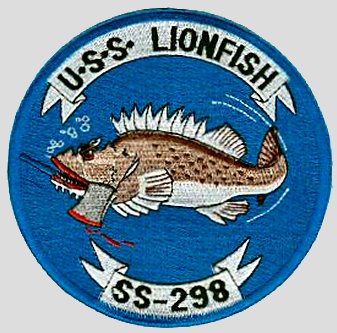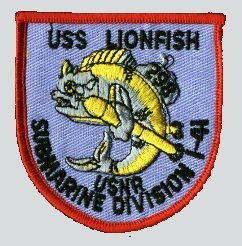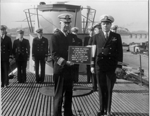 |
520k |
RADM Thomas Withers USN, during commissioning of Lionfish (SS-298) at Navy Yard Portsmouth N.H.
RADM Withers plaque presented to ship by the American Auxillary of the state of Pennsylvania to the 1st CO of the boat, LT. CDR. Edward D. Spruance, USN.
|
USN photo # 80-G-1220 from NARA, College Park, Maryland, courtesy of Sean Hert. |
 |
722k |
RADM Thomas Withers USN, during commissioning of Lionfish (SS-298) at Navy Yard Portsmouth N.H.
RADM Withers addresses officers and crew. |
USN photo # 80-G-1221 from NARA, College Park, Maryland, courtesy of Sean Hert. |
 | 165k | Portside view of the Lionfish (SS-298), possibly at Midway Island, 22 May 1945.
| USN photo courtesy of ussubvetsofwwii.org. |
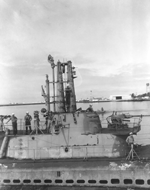 | 248k | View of the Lionfish's (SS-298) fairweather & secondary armament at Midway Island, 22 May 1945.
| USN photo courtesy of ussubvetsofwwii.org. |
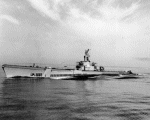 | 18k | Lionfish (SS-298), underway during WW II. | Courtesy of John Hummel, USN (Retired). |
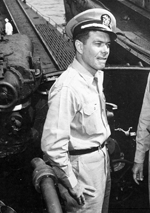 | 131k | Lionfish's (SS-298) first captain was Lieutenant Commander Edward Dean Spruance, son of World War II Admiral Raymond Spruance. | Photo courtesy of Bill Gonyo.
|
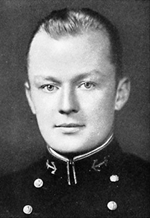 |
55k |
Cmdr Bricker Mcdowell Ganyard was the commanding officer of the Lionfish (SS-298) from June 1945 to August 1945. |
USN photo courtesy of Lucky Bag yearbook via Bill Gonyo. |
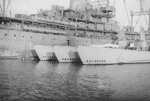 | 197k | The submarine tender Griffin (AS-13), at Midway with three of her charges between 26 August and 1 September 1945 The three boats are not identified, but boats at Midway at that time included Piranha (SS-389), Lionfish (SS-298), Moray (SS-300), Devilfish (SS-292),and Hackleback (SS-295).
The outboard boat is an EB boat, but none of the above boats are EB boats, all Cramp or Portsmouth-built, so they are unidentified for now. | USN photo from the collection of CWO 4 Benton E. Buell, USN, courtesy of David Buell. |
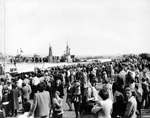 | 1.40k | Lionfish (SS-298), outboard, and Aspro (SS-309) arrive at Mare Island on 11 September 1945 for decommissioning.
| Vallejo Naval and Historical Museum photo # MINSY 6330-9-45 TH, courtesy of Darryl L. Baker. |
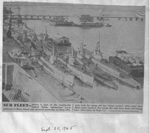 |
1.18k |
The table below lists the location of submarines at Mare Island on 20 September 1945. This information was pulled from microfiche copies of the hand written shipyard journals. I'm surprised that both the clipping and my table show 21 subs at the yard on the date in question. The photo is looking north and berth 3 is at the top of the photo and then the berths run down or south.
Berth 3 - Springer (SS-414) & Spadefish (SS-411)
Berth 4 - Guavina (SS-362) & Barbero (SS-317)
Berth 5 - Hammerhead (SS-364), Tinosa (SS-283), Mapiro (SS-376) & Moray (SS-300)
Berth 6 - Bream (SS-243), Seahorse (SS-304), Batfish (SS-310) & Aspro (SS-309)
Berth 7 - Pomfret (SS-391), Parche (SS-384) & Sunfish (SS-281)
Berth 8 - Queenfish (SS-393)
Berth 9 - Lionfish (SS-298) & Plaice (SS-390)
Dry Dock 1 - Bashaw (SS-241) & Mingo (SS-261)
Berth 12 - Guitarro (SS-363). |
Photo i.d. & text courtesy of Darryl L. Baker.
Photo courtesy of Ron Reeves (of blessed memory).
|
 | 137k | Reserve fleet at Mare Island, circa January 1946. There are 52 submarines and 4 Sub Tenders in this photo. This photo is a Berthing list identifying the ships in the picture.
| Photo commemorating 50 years, U. S. Submarine Veterans of WW II 1996 calendar, courtesy of Darryl L. Baker. |
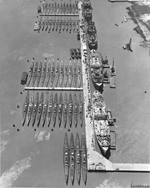 | 453k | Photo of the Reserve fleet at Mare Island, circa January 1946. There are 52 submarines and 4 Sub Tenders in this photo. Whether coincidental or on purpose, the number of boats in the photo is the same as that which were lost in WW II.
From back to front and left to right, first group of 12 boats:
Sand Lance (SS-381)
Tunny (SS-282)
Aspro (SS-309)
Lionfish (SS-298)
Guvania (SS-362)
Sunfish (SS-281)
Macabi (SS-375)
Gurnard (SS-254)
Pampanito (SS-383)
Mingo (SS-261)
Guitarro (SS-363)
Bashaw (SS-241)
From back to front and left to right, second group of 12 boats:
Sealion (SS-315)
Hammerhead (SS-364)
Bream (SS-243)
Seahorse (SS-304)
Tinosa (SS-283)
Pintado (SS-387)
Mapiro (SS-376)
Pipefish (SS-388)
Moray (SS-300)
Batfish (SS-310)
Hackleback (SS-295)
Bluegill (SS-242)
From back to front and left to right, third group of 12 boats:
Hawkbill (SS-366)
Menhaden (SS-377)
Perch (SS-313)
Loggerhead (SS-374)
Barbero (SS-317)
Baya (SS-318)
Hardhead (SS-365)
Spadefish (SS-411)
Springer (SS-414)
Devilfish (SS-292)
Kraken (SS-370)
Dragonet (SS-293)
From back to front and left to right, fourth group of 12 boats:
Lamprey (SS-372)
Piranha (SS-389)
Manta (SS-299)
Pargo (SS-264)
Rancador (SS-301)
Archerfish (SS-311)
Mero (SS-378)
Sawfish (SS-276)
Spot (SS-413)
Lizardfish (SS-373)
Jallao (SS-368)
Icefish (SS-367)
From back to front and left to right, last group of 4 boats:
Steelhead (SS-280)
Puffer (SS-268)
Stickleback (SS-415)
Trepang (SS-412)
From back to front, Submarine Tenders group of 4 ships:
Pelias (AS-14)
Aegir (AS-23)
Euryale (AS-22)
Griffin (AS-13)
| Photo commemorating 50 years, U. S. Submarine Veterans of WW II 1996 calendar, courtesy of Darryl L. Baker. |
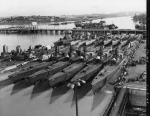 |
900k |
Inactivated submarines at Mare Island on 3 January 1946.
Front row left to right: Sand Lance (SS-381), next two could be Sealion (SS-315) and Seahorse (SS-304), Searaven (SS-196), Pampanito (SS-383), Gurnard (SS-254), Mingo (SS-261), Guitarro (SS-363), Bashaw (SS-241).
Back row left to right: Unknown, Tunny (SS-282), next three could be Sargo (SS-188), Spearfish (SS-190), and Saury (SS-189), Macabi (SS-375), Sunfish (SS-281), Guavina (SS-362), Lionfish (SS-298),Piranha (SS-389).
The Scabbardfish (SS-397) is docked in ARD-11 on the other side of the causeway.
The mixture of boats
from the Salmon/Sargo, Gato, and Balao classes illustrate the clear
differences in the conning tower fairwaters and the periscope shears that
can be used to identify boats. The high bridges with the uncovered support
frames (the "covered wagon" look) of the Gato's and Salmon/Sargo's contrast
with the low and sleek look of the Balao's. The fatter, more robust
periscope shears of the Balao's are markedly different from the thinner
shears with more supporting structure of the Gato's and Salmon/Sargo's .
The differences in the pattern of the superstructure limber holes can also
be used for identification purposes. The single row of large semi-circular
holes identify Electric Boat or Manitowoc boats. A dual row of smaller
rectangular holes mark the government built boats. Also note that the
EB/Manitowoc boats have the deck mounted, T-shaped JP sonar head on the
starboard side of the forward deck, while the government boats have it on
the port side.
EB/Manitowoc boats had the anchor on the starboard side, the government
boats on the port side. A close look will show that some of the boats have
had the anchor removed and the hawsepipe plated over as part of the mothball
process.
Most of the boats have the late war radar outfit of the SJ surface search
(small dish) and SV air search (large dish). The Balao's and some of the
Gato's have the SS dish mounted on a separate large mast aft of the
periscopes. The older Salmon/Sargo's and Gato's have a much smaller mast.
Searaven appears to have had her radars already removed.
Searaven is
actually sporting a late war SJ surface search antennae mounted to starboard
of the periscopes. This is a rare installation. Most often it was mounted
forward (early war) or aft (late war) of the 'scopes shears. Her air search
set is a late war SD antennae mounted on a stub mast directly aft of the
'scopes. Searaven never received the much more capable SV air search set.
Having been assigned to training duties after November, 1944 it was probably
felt that the SV set was not necessary.
One strange thing: almost all of the boats appear to have the outer doors of
the forward torpedo tubes open. Even though the boats have an interlock
system that prevents the breech and outer doors from being opened at the
same time, this is an unusual thing to do and a potential source of
catastrophic flooding.
|
USN photo # 17-46, courtesy of Darryl L. Baker.
Text courtesy of David Johnston |
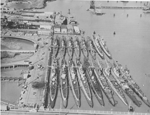 | 289k | Inactivated submarines at Mare Island in early 1946.
Front row left to right: Sand Lance (SS-381), next two could be Sealion (SS-315) and Seahorse (SS-304), Searaven (SS-196), Pampanito (SS-383), Gurnard (SS-254), Mingo (SS-261), Guitarro (SS-363), Bashaw (SS-241).
Back row left to right: Unknown, Tunny (SS-282), next three could be Sargo (SS-188), Spearfish (SS-190), and Saury (SS-189), Macabi (SS-375), Sunfish (SS-281), Guavina (SS-362), Lionfish (SS-298),Piranha (SS-389).
The Scabbardfish (SS-397) is docked in ARD-11 on the other side of the causeway.
Tiru (SS-416) is on the ways in upper left hand side of photo. Two ferry boats (to the right of Tiru's ways) are YHB-2 / [ex-Post of Stockton] and YHB-21 / [ex-Tamalpais]. | Photo i.d. courtesy of Darryl L. Baker.
USN photo courtesy of Scott Koen & ussnewyork.com. |
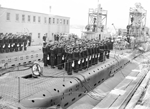
0829820 |
405k |
Re-commissioning of Lionfish (SS-298) and Scabbardfish (SS-397) at Mare Island 31 January 1951. |
Photo from the collection of the Vallejo Naval & Historical Museum courtesy of Darryl L. Baker. |
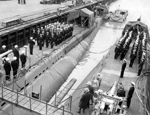
0829821 |
1.38k |
Stern views of the two subs. |
Photo from the collection of the Vallejo Naval & Historical Museum courtesy of Darryl L. Baker. |
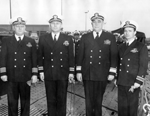
0839715 |
924k |
Interesting collection of offficers gathered for the re-commissioning of Lionfish (SS-298) & Scabbardfish (SS-397) at Mare Island on 31 January 1951.
Officers are from left to right.
Capt. Willis A. Lent – Commander, Mare Island Group, Pacific Reserve Fleet. He wears two Navy Cross Stars (1) Commanding Officer, Grenadier (SS 210) & (2) Commanding Officer, Triton (SS-201) during WWII.
LCDR Richard M. Wright – Commanding Officer of Scabbardfish (SS-397). He wears the Silver Star for actions as Asst. Approach Officer of Spadefish (SS 411) WWII and Navy & Marine Corps Medal for his action aboard Cochino (SS 345) in 1948 sinking.
RADM Thomas R. Cooley – Deputy Commander, Pacific Reserve Fleet. He wears the Legion of Merit for his action as Commanding Officer, Washington (BB- 56) during WWII.
LCDR Arthur G. McIntyre – Commanding Officer, Lionfish. He wears the Prisoner of War Medal for 22 months as a Japanese prisoner in WWII after sinking of Grenadier. He also wears a Purple Heart.
|
Photo from the collection of the Vallejo Naval & Historical Museum courtesy of Darryl L. Baker. |
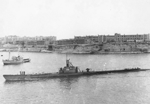 | 141k | Portside view of the Lionfish (SS-298) on a Mediterranean cruise, during which she visited Malta and, after participating in NATO exercises, Izmir, Phaleron, Taranto, and Naples between 18 October to 12 December 1952. She is pictured on 31 October.
| USN photo courtesy of ussubvetsofwwii.org.
Text courtesy of DANFS. |
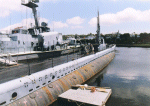 | 117k | Lionfish (SS-298), as a memorial on permanent display at Fall River MA. | Courtesy of Brian J. Johnson. |
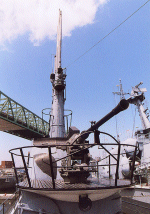 | 74k | Lionfish (SS-298), in her berth at Fall River MA. | Courtesy of Brian J. Johnson. |
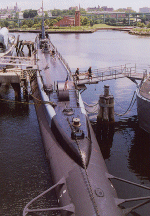 | 87k | Lionfish (SS-298), in her berth at Fall River MA. | Courtesy of Brian J. Johnson. |
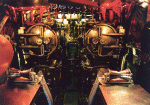 | 172k | Lionfish (SS-298), forward torpedo room. | Courtesy of Brian J. Johnson. |
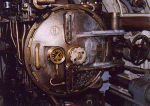 | 164k | Lionfish (SS-298), after torpedo room. | Courtesy of Brian J. Johnson. |
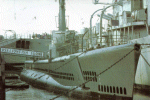 | 164k | Lionfish (SS-298) in her berth at Fall River MA. | Courtesy of Jack Treutle (of blessed memory). |
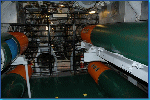 | 119k | Lionfish (SS-298), forward torpedo room. | Courtesy of Larry Backus. Photo I.d. courtesy of Ron Reeves (of blessed memory) |
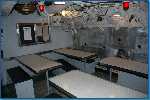 | 60k | Crew's mess aboard the Lionfish (SS-298), October 2008. | Courtesy of Larry Backus. |
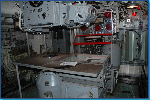 | 74k | Basic control room view looking forward of a Gato, Balao, or Tench class submarine.
Chart Table with DRT and main gyro under it. Over table is a fathometer, and a MK4. The MK4 gives you bearings from either radar, sonar, or periscope. The black handle on the side selects which; secondary steering in front of table...with aux gyro...open door to forward battery...hydraulic manifold left upper with christmas tree above it...(to open ballast tank vents)
On the far left you have the Blow and Vent Manifold. This controls the MBT vents and has the air valves used to blow the ballast tanks. Just to the left and above is the "christmas tree" status indicator which showed the open/closed status of various hull openings like hatches.
In the left corner appears to be a Dead Reckoning Analysis Indicator (DRAI), which is navigational gear. Hard to tell though.
Directly ahead of the chart table is the wheel for the helm. Above the wheel the red gauges are the engine order telegraphs and the rudder angle indicator. There should be a gyro repeater in there somewhere, but I can't see it.
Underneath the chart table is a barrel-like object. This is a gyro compass and is probably a Mk-19. Just forward of the helm is another one and this is probably the Mk-27 backup gyro, but I might be wrong on that one. Looks a little big for a Mk-27.
The square glass insert in the chart table covers the mechanical chart plotter. Using inputs from the gyros and the DRAI, it would shine a small beam of light upwards onto a piece of tracing paper, making a track of the ship's course. We called this the "bug". The controls for setting the bug are just below the glass insert.
Directly above the water tight door is a gray battle lantern. Above and to the left of that is the handwheel for the salvage air valve. This allowed you to pressurize the forward battery compartment in case of flooding.
| Courtesy of Larry Backus. Photo I.d. & text courtesy of John Hummel, David Johnston (USN, retired) & Ron Reeves (of blessed memory) |
 | 135k | The Lionfish (SS-298) under tow for restoration and TLC at Fall River MA. | Photo courtesy of Joe Lombardi, Ocean Technical Services via Ron Reeves (of blessed memory) |
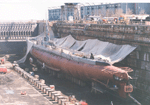 | 187k | Stern view of the Lionfish (SS-298) while undergoing restoration and TLC at Fall River MA. | Photo courtesy of Joe Lombardi, Ocean Technical Services via Ron Reeves (of blessed memory) |
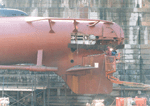 | 159k | Sparks of love emanate from the stern of the Lionfish (SS-298) while undergoing restoration and TLC at Fall River MA. | Photo courtesy of Joe Lombardi, Ocean Technical Services via Ron Reeves (of blessed memory) |
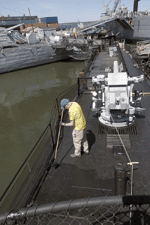 | 465k | A clean boat is the Lionfish (SS-298), June 2019. | Photo courtesy of Yu Chu.
|
